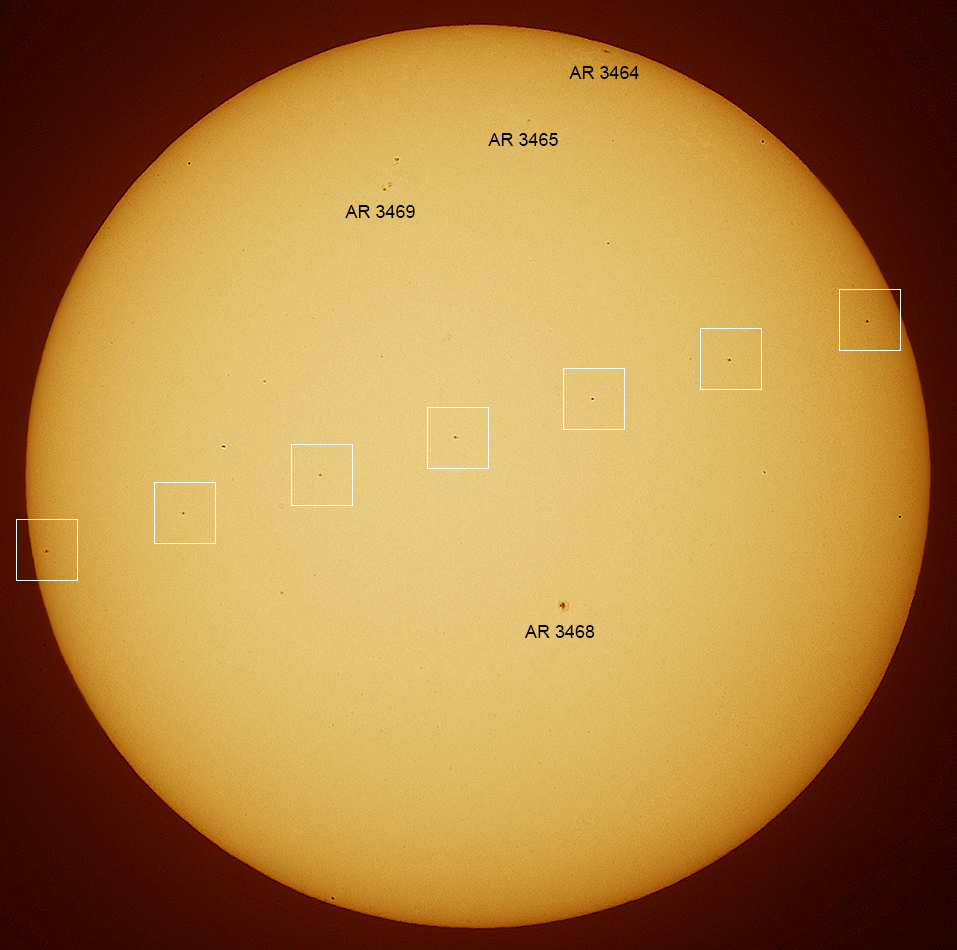
I have a particular interest in satellite transits across the solar/lunar surfaces due to the opportunity they present the lucky observer
to discern greater physical detail and structure as a result of their silhouette against the bright background of the Sun and/or Moon; the
ability to restrict the satellite's location in the daytime or evening sky to an area measuring 0.5°x0.5° with little or no effort; it
permits for the bypassing of satellite tracking which itself is a challenge due the very short period transits are visible during a particular
overhead pass; and the difficulty in obtaining accurate and timely orbital elements and TLE's. As this "search and identify" project has
literally become a frequent ritual, I expect this web page to be updated constantly with more and more images of the very unique phenomena of
satellite transits across the solar and/or lunar disks.
Note: The capture of a solar transit by the International Space Station was an incessant chase for 3-4 years and
until July 28, 2005 when the ISS (with
STS-114)
was finally captured transiting against the Sun and which included the space shuttle Discovery. Approximately nine months later, the ISS was
also caught transiting the rising moon (click
here) albeit at a very low altitude. My best ISS transit captures occurred in
2018 and 2023
when the ISS was at a range of 441.6 km and 551.4 km away, respectively, when transiting the Sun whereas in 2010 I was able to also capture
the ISS during the day transiting Jupiter at a range of 439.5 km as well as
Mars at a range of 565.9 km.
With the launch of the Chinese Space Station Tiangong-1 module in 2011 and the Tiangong-2 module in 2016, a new challenge presented itself
and where a small number of transit opportunities have presented themselves involving both the Sun and Moon. However, orbital maneuvers and
the weather play a vital role with such events and, regrettably, they proved repeatedly to be prohibitive stumbling blocks. However, on
Aug 29th, 2023 everything seemingly came together thanks to a stable orbit, favourable weather conditions and the very good altitude of Sun
which finally permitted for the pursuit and successful
capture
of the Tiangong Space Station transiting the Sun for a mere 0.69 seconds. The effort below represents the second successful capture of the
Chinese Space Station Tiangong transiting the Sun in the span of less than two months but this time at a range of 1026 km and with a transit
duration of 1.42 seconds and apparent diameter of only 3.62 arc-seconds albeit at a low altitude (17.8° above the horizon).
The Chinese Space Station Tiangong ("Sky Palace") represents China's most recent entry into space and follows the Tiangong-1 and
Tiangong-2 modules. It is approximately one-third the size of the ISS (by volume) and has a permanent crew of three astronauts but can accomodate
up to six astronauts during missions involving crew rollovers. It has a current mass of 96,000 kg and measures 55.6 meters in length and 39.0
meters across with plans to expand the station from the three existing modules to a total of six modules in the future with the fourth module
("Xuntian") tentatively scheduled for launch in 2024.
Note: For a complete set of images captured so far involving satellite transits of both the Sun and Moon,
click here.
|
Satellite(s): Tiangong USSPACECOM Cat No: 48274 (Tianhe) Physical Dimensions: 55.6 x 39.0 m Orbit / Inclination: 381 x 390 km, 41.47° Range (Image): 1026 km Angular Diameter: 3.62" Pass Details (ISS):
Launch Date (UTC):
|
 |
Date: Oct 21, 2023 09:21:16 - 09:21:17 UT+3 Location: Athens, Greece Equipment: AP 160 f/7.5 StarFire EDF AP 2x Convertible Barlow AP 1200GTO/CP3 GEM Canon EOS 6D Mark I Baader BCF2 Filter Baader UV/IR-Cut filter Baader ND-5 (full-aperture) Exposures: 7 x 1/2500 sec ISO 2000 RAW Image Format Custom White Balance Manual Mode Continuous Servo Mode Software: Digital Photo Pro V4.6.30.0 Photoshop CS6 Processing: RAW to TIFF (16-bit conv) Brightness/Contrast Unsharp Masking Resampling JPG Compression |
||||||||||||||||||||||||||||||